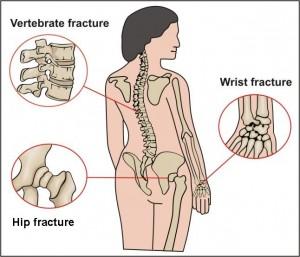Women who’ve been treated for breast cancer may be at increased risk for osteoporosis because:
- Estrogen has a protective effect on bone, and reduced levels of the hormone trigger bone loss.
- Chemotherapy or surgery, may cause a loss of ovarian function and, as a result experience a drop in estrogen levels.
- Women who were pre-menopausal before their breast cancer treatment tend to go through menopause earlier than those who have not had breast cancer.
- Studies suggest that chemotherapy also may have a direct negative effect on bone. In addition, the breast cancer itself may stimulate the production of osteoclasts, the cells that break down bone.
To reduce your risk for osteoporosis:
Pay Attention to your Nutrition: Eat a well-balanced diet rich in calcium and vitamin D. Good sources of calcium  include low-fat dairy products; dark green, leafy vegetables; and calcium-fortified foods and beverages. Supplements can help ensure that the calcium requirement is met each day, especially in people with a proven milk allergy. The Institute of Medicine recommends a daily calcium intake of 1,000 mg (milligrams) for men and women up to age 50. Women over age 50 and men over age 70 should increase their intake to 1,200 mg daily.
include low-fat dairy products; dark green, leafy vegetables; and calcium-fortified foods and beverages. Supplements can help ensure that the calcium requirement is met each day, especially in people with a proven milk allergy. The Institute of Medicine recommends a daily calcium intake of 1,000 mg (milligrams) for men and women up to age 50. Women over age 50 and men over age 70 should increase their intake to 1,200 mg daily.
Vitamin D plays an important role in calcium absorption and bone health. Food sources of vitamin D include egg yolks, saltwater fish, and liver. Many people, especially those who are older or housebound, may need vitamin D supplements to achieve the recommended intake of 600 to 800 IU (International Units) each day.
Exercise: Like muscle, bone is living tissue that responds to exercise by becoming stronger. The best activity for your bones is weight-bearing exercise that forces you to work against gravity. Some examples include walking, climbing stairs, weight training, and dancing. Regular exercise, such as walking, may help prevent the bone loss of osteoporosis
Maintain a Healthy lifestyle: Smoking is bad for bones as well as the heart and lungs. Women who smoke tend to go through menopause earlier, resulting in earlier reduction in levels of the bone-preserving hormone estrogen and triggering earlier bone loss. In addition, smokers may absorb less calcium from their diets. Some studies have found a slightly higher risk of breast cancer in women who drink alcohol, and evidence suggests that alcohol can have a negative effect on bone health. Those who drink heavily are more prone to bone loss and fracture, because of both poor nutrition and an increased risk of falling.
Get Bone Density Test: A bone mineral density (BMD) test measures bone density in various parts of the body. This safe and painless test can detect osteoporosis before a fracture occurs and can predict one’s chances of fracturing in the future. The BMD test can help determine whether medication should be considered. A woman recovering from breast cancer should ask her doctor whether she might be a candidate for a bone density test.
Medication: There is no cure for osteoporosis. But, several medications are available to prevent and treat this disease.

